Key takeaways:
- Sustainable water policies that involve community engagement and innovative practices, like rainwater harvesting, can effectively address water scarcity and enhance resource management.
- Collaboration among diverse stakeholders and data-driven decision-making are essential for creating effective water policies that adapt to changing conditions.
- Challenges in enforcement often arise from funding limitations, conflicting interests, and lack of public awareness, highlighting the need for transparency and community involvement in policy development.
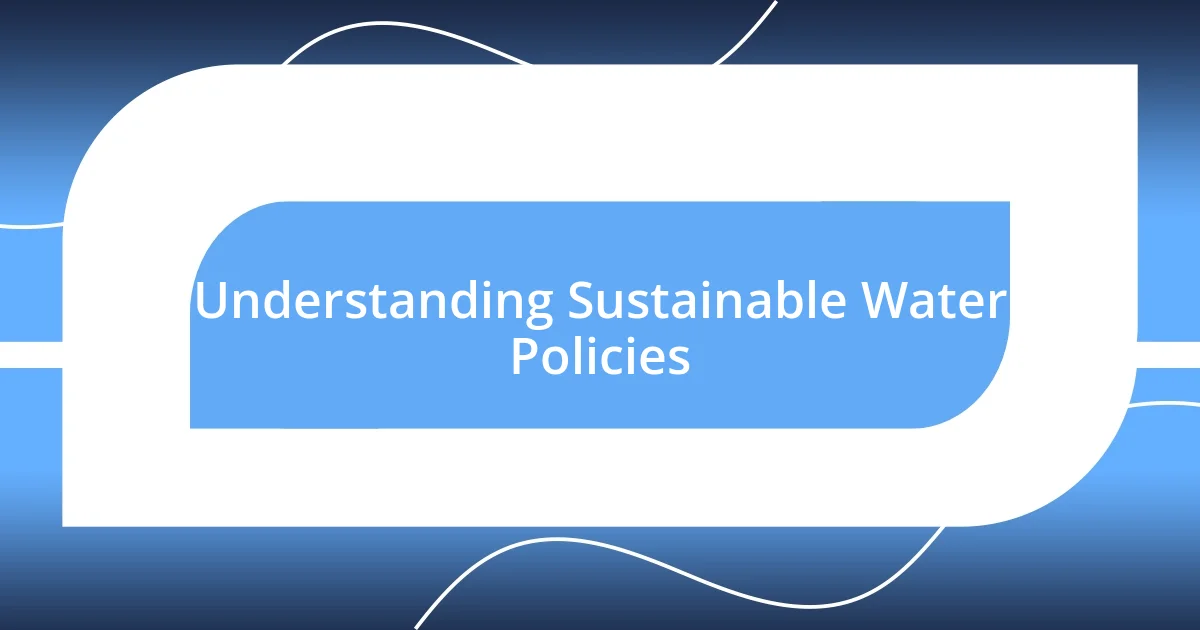
Understanding Sustainable Water Policies
Sustainable water policies are designed to balance the needs of people with the health of ecosystems. I vividly remember a workshop I attended where a local water manager shared how their community struggled with droughts. It was eye-opening to see how a well-crafted water policy helped them allocate resources efficiently while protecting their river’s biodiversity.
When I think about sustainable water policies, I often wonder how many people truly grasp their importance. For instance, during my travels, I encountered a village that implemented a rainwater harvesting system, turning scarcity into abundance. This simple yet innovative policy transformed their approach to water use, showcasing that sustainability isn’t just theoretical; it can be a tangible reality.
It’s fascinating to realize that these policies involve community voices and scientific research. At one point, I volunteered for an initiative that aimed to educate residents about the impact of their water use habits. Witnessing their realization that small changes could contribute to a larger goal was incredibly fulfilling, reminding me that each of us has a role in driving the success of sustainable water initiatives.
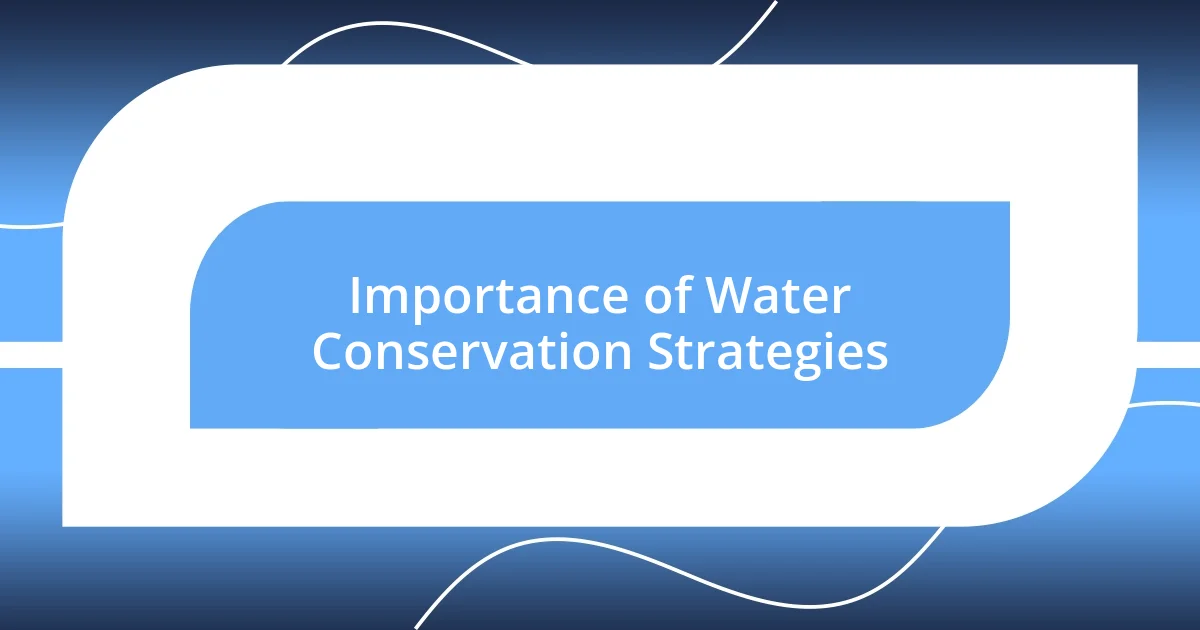
Importance of Water Conservation Strategies
Water conservation strategies are crucial as they directly impact our ecological balance and resource availability. I recall a moment at a community meeting, where passionate residents shared their concerns about dwindling water sources. Their stories highlighted not just statistics, but the emotional weight of watching a vital resource fade away. It’s these conversations that drive home the importance of proactively managing our water use through effective strategies.
Here are a few key reasons why water conservation should be a priority:
- Environmental Protection: Helps preserve natural habitats and biodiversity.
- Resource Efficiency: Reduces the strain on local water supplies and promotes sustainable usage.
- Cost Savings: Lower water bills and reduced infrastructure costs from less demand.
- Community Resilience: Strengthens neighborhoods against droughts and other water-related challenges.
- Climate Adaptation: Prepares communities for the impacts of climate change by securing water sources.
The collective realization at that meeting was powerful; everyone recognized that by adopting simple conservation practices, they could be part of a larger movement toward sustainability. It’s moments like these that inspire me to advocate for water conservation strategies, as they showcase the profound ripple effect of informed action in our communities.
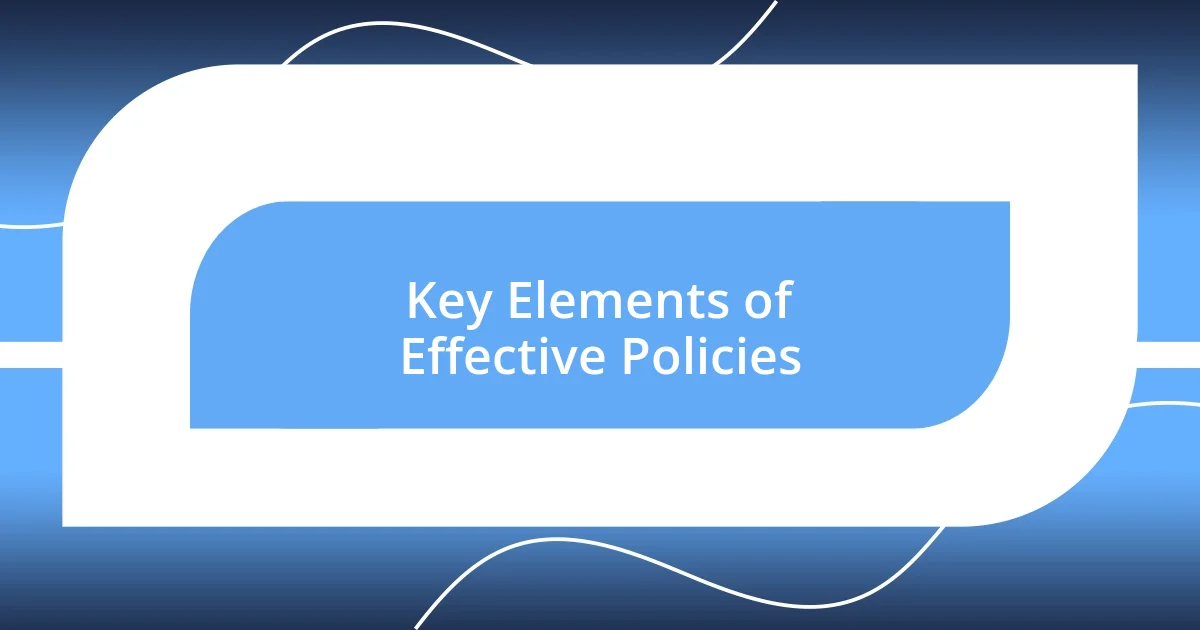
Key Elements of Effective Policies
Sustainable water policies thrive on collaboration and clear communication. In my experience, having stakeholders from various backgrounds—such as farmers, urban planners, and environmentalists—come together often leads to the most effective solutions. I recall attending a panel discussion where each group presented their unique challenges related to water supply. The synergy that arose made me realize the importance of inclusive policy-making in ensuring that everyone’s voice is heard and considered.
One vital element in crafting effective policies is data-driven decision-making. I once worked on a project that involved using satellite imagery to monitor water levels in local reservoirs. This approach revealed patterns we hadn’t anticipated, prompting the community to revise their resource allocations. This taught me that factual insights can significantly enhance our understanding of water needs and allow policies to adapt to changing conditions.
Lastly, education and outreach cannot be overstated. My heart still swells when I think about a workshop I facilitated on water-saving techniques. The excitement in the participants’ eyes as they learned about rain gardens and drought-tolerant landscaping felt contagious. It truly reinforced my belief that informed communities are empowered to embrace sustainable practices more readily.
| Key Element | Description |
|---|---|
| Collaboration | Involves diverse stakeholders to foster comprehensive solutions. |
| Data-Driven Approaches | Utilizes factual insights for adaptive resource management. |
| Education and Outreach | Empowers communities to engage in sustainable practices. |
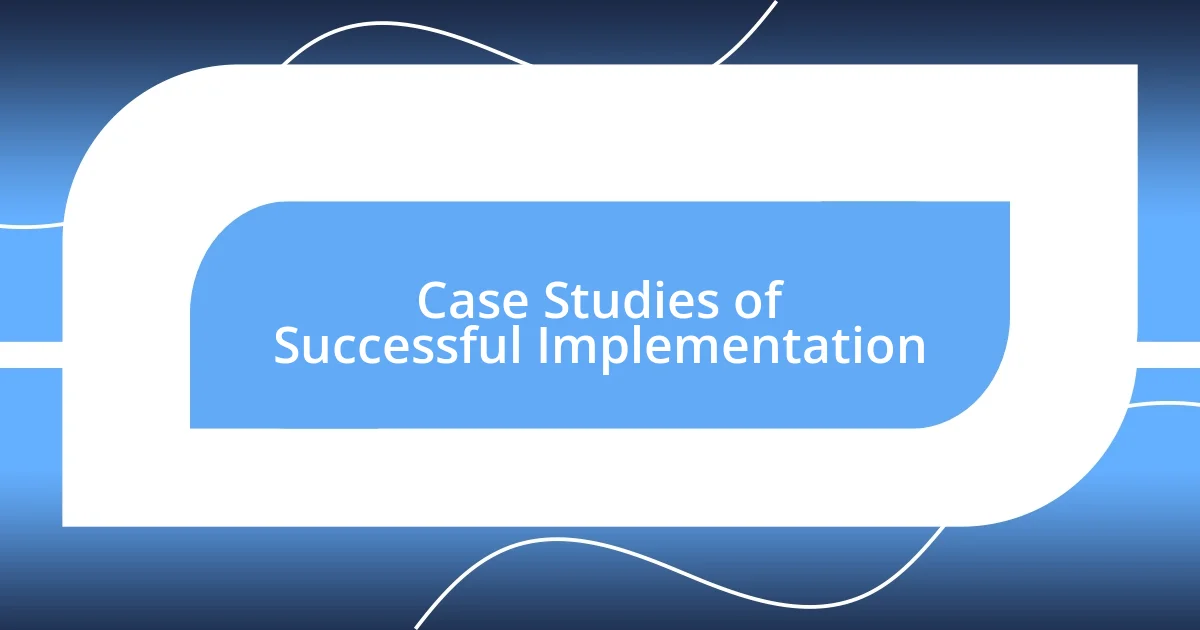
Case Studies of Successful Implementation
One striking case I observed was in Cape Town, South Africa, during their severe drought crisis. I remember the intensity in the air as residents faced real water scarcity, leading the city officials to implement drastic water-saving measures. The “Day Zero” campaign, which aimed to conserve water by restricting usage to 50 liters a day per person, sparked a deep sense of responsibility among the community. It made me wonder, how far are we willing to go in our daily lives to protect such an essential resource?
Another compelling example comes from Israel, a pioneer in water management. Their investment in technologies like drip irrigation has transformed agriculture in arid regions. I was inspired when I learned that these methods have allowed farmers to reduce water consumption by up to 80%. Witnessing agricultural yields increase while using significantly less water made me hopeful that innovation could lead the way toward sustainability—a question echoed in many discussions I’ve had: can we adopt similar strategies in regions facing water shortages?
Finally, I have fond memories of participating in a local ‘water square’ initiative in my community. The goal was to capture and reuse stormwater to irrigate public gardens. It was fascinating to see kids excitedly learning about water cycles while digging up the earth. Such community-driven efforts reinforce my belief that when people come together to find solutions, it can lead to impactful, sustainable changes. Isn’t it remarkable how collective action can make a tangible difference?
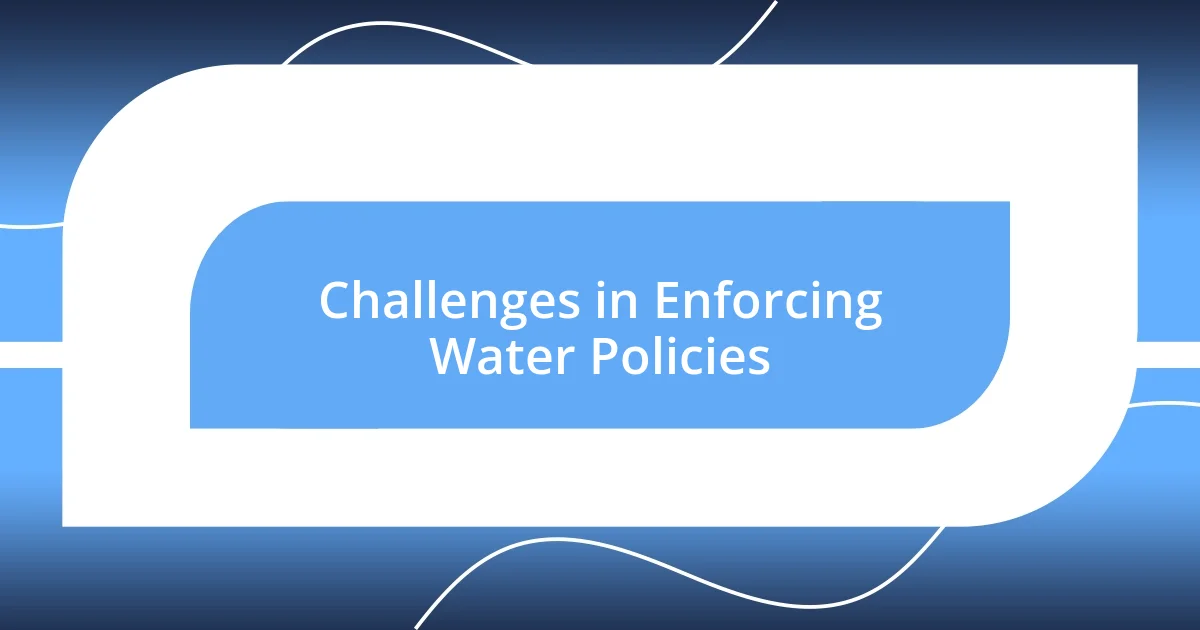
Challenges in Enforcing Water Policies
Enforcing water policies often hits roadblocks due to insufficient funding and resources. I remember a community meeting where local leaders passionately discussed plans to improve water infrastructure, yet many simply lacked the budget to turn ideas into reality. It made me realize that without adequate financial support, even the best-laid plans can remain just that—plans, without the power to make a real impact.
Another challenge lies in the conflicting interests of different stakeholders. At a recent workshop, I observed farmers advocating for their water needs while urban residents expressed concerns about conservation. The atmosphere was tense, and I couldn’t help but wonder: how do we balance these competing demands? Reaching a consensus often feels like walking a tightrope, where one misstep can undermine the whole policy framework.
Additionally, the lack of public awareness and engagement can severely hinder enforcement efforts. I recall volunteering for a water conservation campaign, where I encountered numerous people completely unaware of the ongoing policies designed to protect our water resources. It struck me how essential it is to not only create policies but also to foster a sense of ownership and responsibility in the community. How can we expect compliance if the very people affected aren’t informed about the policies in place?
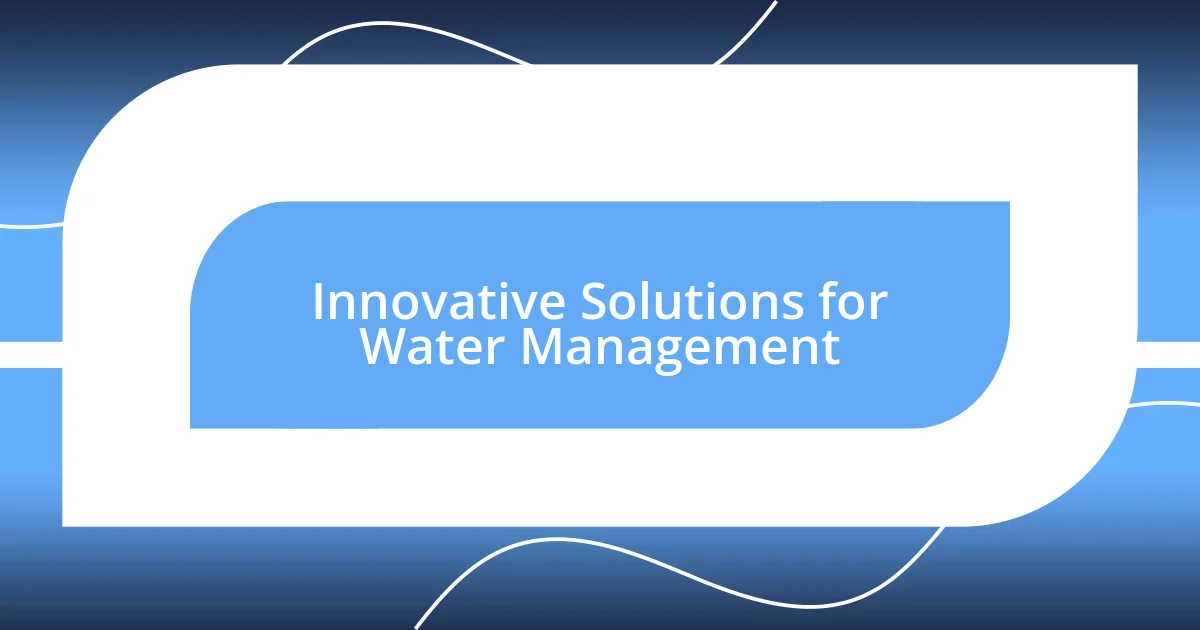
Innovative Solutions for Water Management
One of the most innovative solutions I’ve encountered in water management is the use of smart irrigation systems. A few years ago, I had the opportunity to visit a winery that had recently installed sensors to monitor soil moisture levels. It was exciting to watch how these sensors automatically adjusted watering schedules, ensuring crops received just the right amount of water. Isn’t it fascinating how technology can optimize resource use and potentially revolutionize the way we think about irrigation?
Additionally, I stumbled upon a community project that integrated green roofs in urban areas. I vividly remember attending a workshop where experts shared how these roofs not only reduce stormwater runoff but also improve air quality and promote biodiversity. It got me thinking about the ways small changes in our urban landscapes can lead to bigger environmental impacts. Could such simple innovations encourage other neighborhoods to rethink their relationship with water?
Recently, I was involved in a pilot program that promoted rainwater harvesting in our region. I was surprised to see how effortlessly households could collect water for gardening and other non-potable uses. I still recall the joy on people’s faces as they installed barrels and tuned into conservation practices. This experience made me reflect on how empowering individuals to harness natural resources can create a ripple effect of sustainable practices. Isn’t it remarkable how these innovative solutions can cultivate a deeper connection between people and the environment?
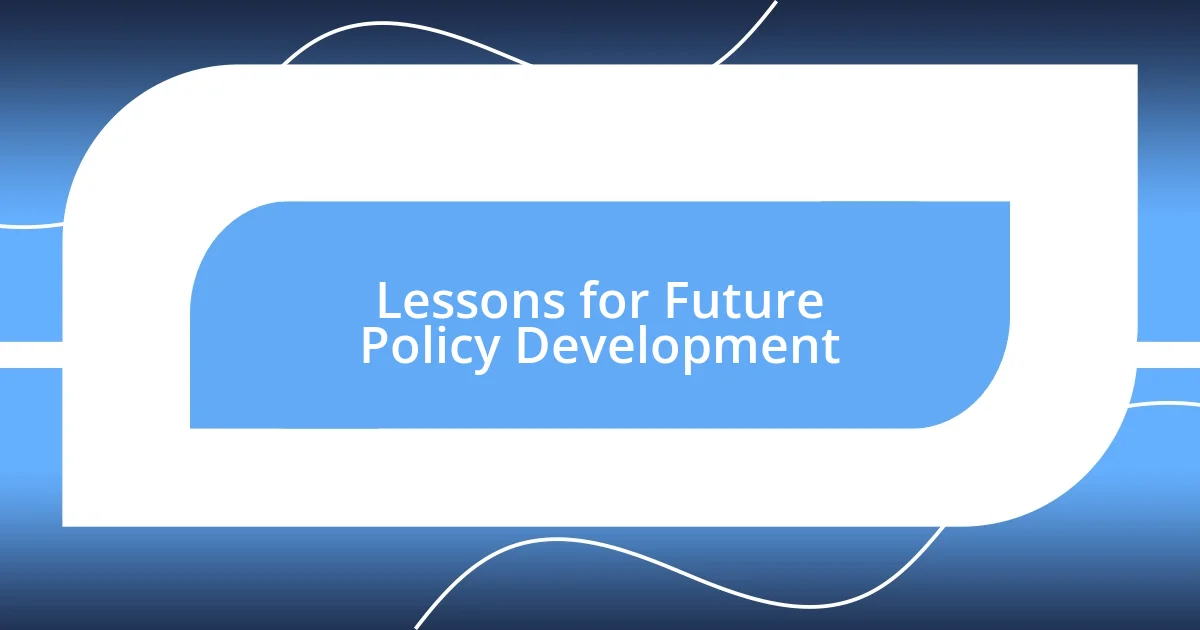
Lessons for Future Policy Development
When I think about lessons for future policy development, the importance of adaptability strikes me. I’ve seen how policies can become rigid, failing to account for evolving environmental conditions and community needs. For instance, in one project I worked on, local policymakers had to rethink water usage regulations in response to a severe drought. It was eye-opening to witness how a flexible approach not only mitigated immediate challenges but also built trust in the community.
Moreover, stakeholder collaboration is crucial for successful policy outcomes. During a recent panel discussion, I listened to different voices—from farmers to city planners—sharing their unique insights. It reminded me of how collaboration can pave the way for innovative solutions. When everyone feels included in the decision-making process, policies are not only more comprehensive but also more likely to gain community support. Isn’t it inspiring how collective efforts can mobilize a community toward sustainable water practices?
Finally, I believe that transparency in policy development can’t be overstated. I recall a workshop where community members expressed frustration over unclear regulations on water usage. Their passion emphasized the need for straightforward communication from policymakers. Transparency cultivates trust and understanding, which are essential for effective enforcement. How can we expect commitment if the rules are murky? Clear communication not only informs the public but also empowers them to engage actively in the stewardship of their water resources.












